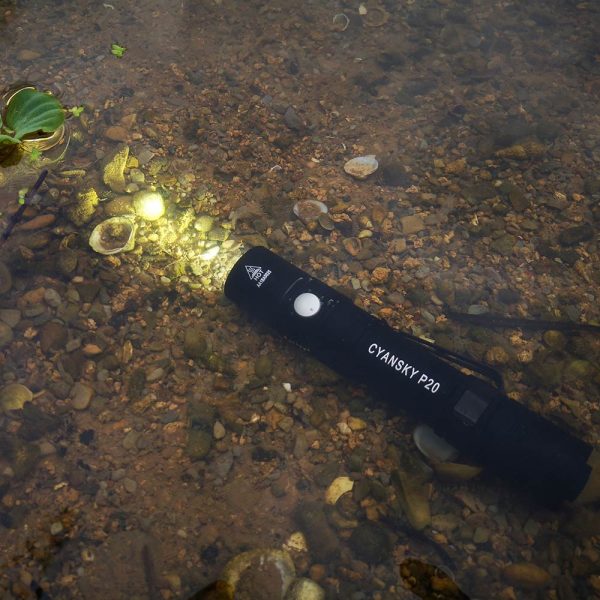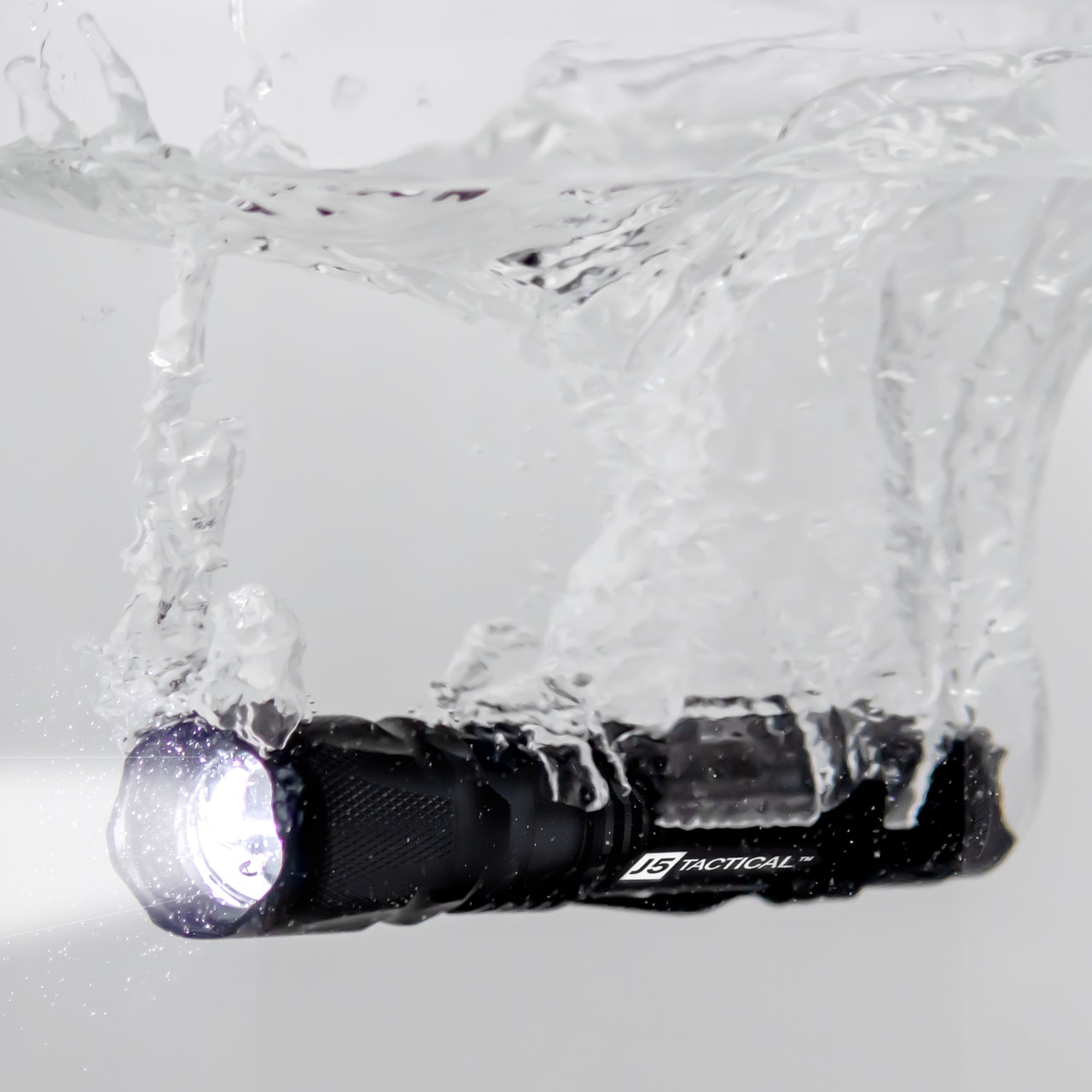IP Ratings and What They Mean for Waterproof Flashlights

IP ratings help you understand how well a flashlight resists solids and liquids. This knowledge ensures you pick the right tool for your needs. For outdoor adventures, an IP65 flashlight withstands rain and dust. Industrial settings demand IP67 for high dust or water exposure. For diving, IPX8-rated waterproof flashlights are essential.
Key Takeaways
IP ratings show how well a flashlight blocks dust and water. Higher numbers mean stronger protection, helping you pick the best flashlight.
For outdoor use, pick a flashlight with the right IPX rating. IPX4 works for light rain, while IPX8 is great for underwater use.
Knowing the difference between waterproof, water-resistant, and water-repellent flashlights helps you choose wisely. Each type is made for different levels of protection.
What Are IP Ratings?
Understanding Ingress Protection
The term "ingress protection" refers to how well a device's enclosure prevents the entry of foreign objects like dust and water. The ingress protection rating system, often shortened to IP rating, measures this effectiveness. It is standardized globally under EN 60529, ensuring consistency across different products and industries.
The International Electrotechnical Commission (IEC) developed this system to classify and compare the sealing levels of enclosures. Initially designed for industrial use, it now helps consumers understand the durability of everyday items like flashlights. By checking the ingress protection standards, you can determine whether a flashlight can withstand specific environmental conditions, such as heavy rain or submersion in water.
The Two-Digit IPX Rating System
The IP rating system uses two digits to indicate the level of protection. Each digit represents a specific type of resistance:
The first digit measures protection against solid objects, such as dust or dirt. It also indicates whether the enclosure prevents access to hazardous parts.
The second digit shows the level of protection against liquids, including water.
A higher number means better protection. For example, an IP67 flashlight offers complete dust protection and can survive temporary immersion in water. If a digit is replaced by an "X," it means the product has not been tested for that aspect. Understanding the types of IP ratings helps you choose the right flashlight for your needs, whether you're hiking in dusty terrain or diving underwater.
Decoding IP Ratings for Waterproof Flashlights

Solid Protection Levels (First Digit)
The first digit in an IPX rating indicates the degree of protection against solid objects. This ranges from no protection (0) to complete dust-tight sealing (6). For example:
Level | Object size protected against | Description |
|---|---|---|
0 | None | No protection against solids. |
1 | >50 mm | Protects against large body parts like the back of your hand. |
2 | >12.5 mm | Prevents entry of fingers or similar objects. |
3 | >2.5 mm | Blocks tools or thick wires. |
4 | >1 mm | Stops most wires and screws. |
5 | Dust protected | Limits dust ingress to ensure proper operation. |
6 | Dust tight | Completely seals out dust. |
For waterproof flashlights, a higher first digit ensures better durability in dusty environments. An IP67 flashlight, for instance, offers complete dust protection, making it ideal for outdoor adventures.
Liquid Protection Levels (Second Digit)
The second digit measures the flashlight’s protection against water. This ranges from no protection (0) to resistance against continuous immersion (8). Here’s a breakdown:
Level | Description |
|---|---|
0 | No protection against water. |
1 | Protects against vertically falling water drops. |
2 | Resists water drops when tilted up to 15 degrees. |
3 | Handles water sprays at angles up to 60 degrees. |
4 | Protects against splashes from any direction. |
5 | Resists low-pressure water jets. |
6 | Withstands high-pressure water jets. |
7 | Submersible up to 1 meter for 30 minutes. |
8 | Suitable for continuous immersion beyond 1 meter. |
An IPX8 rating ensures a flashlight can handle prolonged underwater use, making it perfect for diving or underwater repairs.
Common IP Ratings for Waterproof Flashlights (IPX4, IPX7, IPX8)
Waterproof flashlights often feature IPX4, IPX7, or IPX8 ratings. Each offers a specific degree of protection against water:
IPX4: Splash-resistant from any direction. Ideal for light rain or accidental splashes during hiking or camping.
IPX7: Submersible up to 1 meter for 30 minutes. Suitable for activities like kayaking or fishing.
IPX8: Designed for continuous immersion beyond 1 meter. Perfect for deep-sea diving or prolonged underwater tasks.
IP Rating | Description | Suitable Use |
|---|---|---|
IPX4 | Splash resistant | Light rain or moisture exposure |
IP67 | Submersible up to 1 meter | Activities near water, such as fishing or boating |
IP68 | Submersible beyond 1 meter | Demanding environments with prolonged water exposure |
Understanding these waterproof ratings helps you choose the right flashlight for your needs. Whether you need a weatherproof flashlight for camping or a waterproof flashlight for diving, the IPX rating ensures you get the right degree of protection against water.
Waterproof, Water-Resistant, and Water-Repellent Flashlights
Key Differences Between the Terms
Understanding the differences between waterproof, water-resistant, and water-repellent flashlights helps you make informed decisions. Each type offers unique levels of protection against water, as shown below:
Type | Description |
|---|---|
Water-Resistant | Designed to resist water penetration to some extent; can handle light rain and brief splashes. |
Water-Repellent | Coated to repel water; prevents moisture from seeping in but not as protective as waterproofing. |
Waterproof | Completely watertight; can be submerged without damage; indicated by IP ratings for protection level. |
Water-resistant flashlights withstand light rain or splashes but cannot handle submersion. Water-repellent models feature a special coating that causes water to bead off, offering limited protection. Waterproof flashlights provide the highest level of protection against water. These are fully sealed and suitable for submersion, with their waterproof ratings determined by IP standards.
Practical Applications for Each Type
Each type of flashlight serves specific purposes based on its level of protection against water:
Water-Resistant Flashlights: Ideal for light outdoor activities like walking in the rain or casual camping. They also work well for everyday use, such as finding items during minor spills.
Water-Repellent Flashlights: Useful for hobbies like photography or arts and crafts. Their coating prevents moisture damage during light exposure. These are also great for pet care, such as walking your dog at night.
Waterproof Flashlights: Perfect for rugged outdoor adventures, including hiking, fishing, and kayaking. They remain reliable in heavy rain or snow. In emergencies, a waterproof flashlight ensures visibility in flooded areas or during storms.
Waterproof flashlights offer unmatched durability and reliability. Their ability to endure harsh conditions makes them essential for demanding environments. Whether you need a flashlight for everyday tasks or extreme adventures, understanding these differences ensures you choose the right tool.
Choosing the Right Waterproof Flashlight
Outdoor and Adventure Flashlights
When choosing a waterproof flashlight for outdoor adventures, you need to prioritize features that ensure reliability in unpredictable environments. Look for an IPX rating that matches your activities. For example, an IPX4 rating protects against splashes, while an IPX8 rating ensures functionality during heavy rain or accidental submersion. LEDs are the preferred illuminant for outdoor use due to their durability and long lifespan. Brightness, measured in lumens, is another critical factor. A flashlight with 300-500 lumens provides sufficient illumination for hiking or camping in dark areas.
Portability matters too. A lightweight and compact flashlight is easier to carry during long treks. Consider models with multiple lighting modes, such as SOS or strobe, for emergencies. Rugged construction ensures the flashlight withstands shocks and harsh conditions. If you plan marine activities, choose a waterproof model with saltwater resistance to prevent corrosion. These features make waterproof LED products ideal for outdoor enthusiasts.
Flashlights for Underwater Use
Underwater flashlights require specialized features to handle submersion and provide reliable lighting. A waterproof rating of IPX8 or higher is essential for protection against liquids. Depth ratings vary based on your needs. Recreational divers typically require flashlights rated for up to 130 feet, while technical divers may need models that work at depths of 492 feet. Brightness levels also differ. For shallow dives, 200-500 lumens suffice, but deeper dives may demand 1000 lumens or more.
Material choice is crucial. Flashlights made from corrosion-resistant materials like aluminum or stainless steel perform well in saltwater environments. Beam type also plays a role. Narrow beams work best in caves, while wide beams are ideal for open water. A shockproof design ensures durability, even in challenging underwater conditions.
Requirement | Details |
|---|---|
Waterproof Rating | Must have a waterproof rating of IPX8 or higher to handle submersion. |
Depth Rating | Recreational diving requires up to 130 feet (40 meters); technical diving requires up to 492 feet (150 meters). |
Brightness Levels | For recreational dives, 200-500 lumens are sufficient; technical divers may need 1000 lumens or more. |
Beam Type | Narrow beams for caves; wide beams for open water. |
Material | Must be made from corrosion-resistant materials like aluminum or stainless steel. |
Shockproof Design | Should withstand drops from heights of up to 2 meters and exposure to saltwater for durability. |
Everyday Waterproof Flashlights
For everyday use, waterproof flashlights offer convenience and reliability. An IPX4 rating is sufficient for light rain or brief water exposure. If you need more protection, consider models with IPX6 or IPX7 ratings. These flashlights handle temporary submersion, making them suitable for activities like fishing or kayaking. IPX8-rated flashlights are ideal for intense water-based tasks, such as scuba diving.
Everyday waterproof flashlights stand out for their durability and consistent performance in all weather conditions. They are built to withstand drops and impacts, ensuring long-term use. These flashlights also provide safety during emergencies, such as power outages or floods. Their versatility makes them a practical choice for casual users and outdoor enthusiasts alike.
Waterproof Rating | Description | Suitable Activities |
|---|---|---|
IPX4 | Great for light rain or brief water exposure | Casual use |
IPX6 | Withstands temporary submersion | Occasional water contact |
IPX7 | Suitable for immersion in water | Fishing, kayaking |
IPX8 | Continuous immersion | Scuba diving, intense water-based expeditions |
IP ratings help you evaluate a flashlight’s durability and water ingress protection. For outdoor activities, water sports, or emergencies, checking the IP rating ensures reliability. High-quality waterproof flashlights offer durability, consistent performance in harsh weather, and safety during emergencies. Investing in the right flashlight guarantees long-term performance and peace of mind.
FAQ
What is the difference between water-resistant and waterproof flashlights?
Water-resistant flashlights handle light rain or splashes. Waterproof flashlights endure submersion. Always check the IP rating to determine the level of protection your flashlight offers.
Can a water-resistant flashlight survive heavy rain?
A water-resistant flashlight can handle light rain but may fail in heavy rain. For better protection, choose a waterproof flashlight with an IPX6 or higher rating.
How do I maintain my water-resistant flashlight?
Clean your water-resistant flashlight after exposure to moisture. Dry it thoroughly before storage. Regular maintenance ensures durability and optimal performance in wet conditions.
See Also
Emergency Flashlight Designed for Long-Lasting Durability
Exploring How Rechargeable Flashlights Discharge Their Power
Selecting the Perfect High-Powered Flashlight for Your Needs
A Complete Guide to Understanding Flashlight Brightness Levels
Finding the Ideal Rechargeable Flashlight for Your Hiking Adventures
